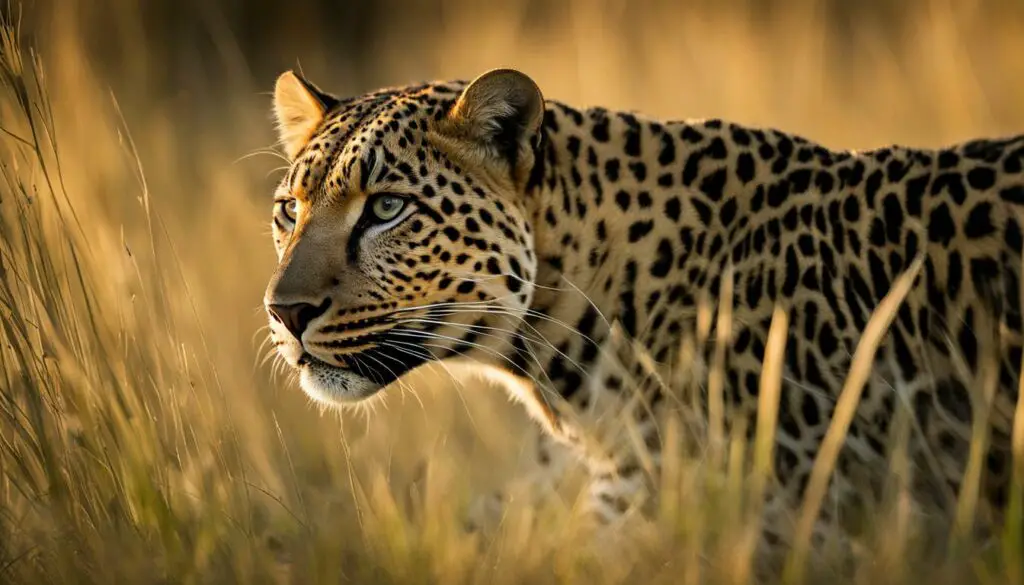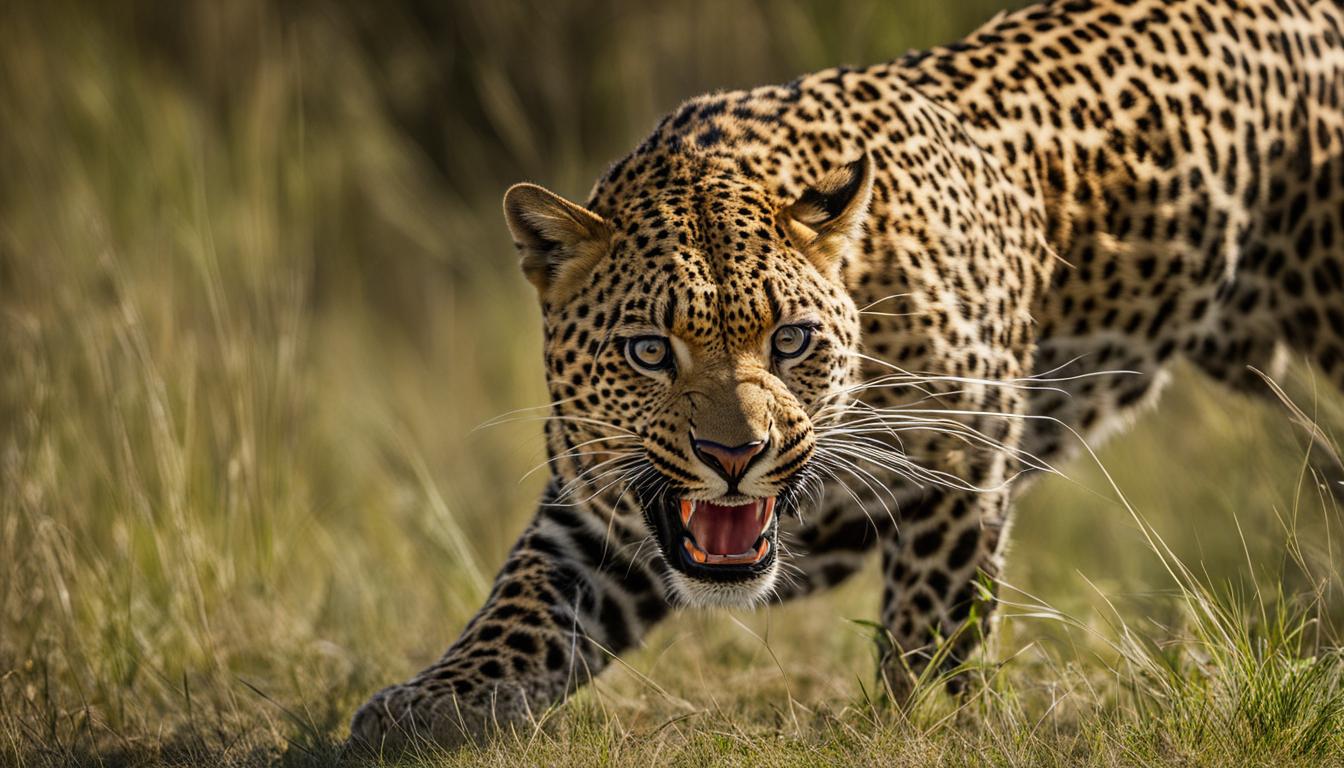Leopards are fascinating predators with an impressive hunting strategy. They employ a range of techniques and behaviors to successfully capture their prey. Understanding their hunting habits and skills provides valuable insights into their survival in various habitats.
When it comes to hunting, leopards are opportunistic and adaptable. They have a wide range of prey, including medium-sized antelopes, fish, birds, wild pigs, amphibians, reptiles, monkeys, and rodents. Their hunting technique involves the use of camouflage and stealth. Leopards rely on their ability to slowly stalk their prey, either over long distances or by patiently waiting in an ambush position.
Once they are close enough, leopards launch a final attack, using their powerful claws and teeth to render the prey helpless. The final bite is typically directed at the neck or throat. After successfully capturing their prey, leopards are known for carrying it up into trees, especially when scavengers are present.
Leopards are skilled hunters with a keen sense of camouflage. They can get as close as five meters to their quarry before launching their attack. While primarily nocturnal, leopards will seize hunting opportunities during the daytime as well. Their hunting technique involves a brief and explosive charge, reaching speeds of up to 60km/h, followed by a bite to the neck to dispatch the prey.
Adaptability is key to the survival of leopards. They can thrive in various habitats, from semi-desert conditions to dense subtropical bush. Leopards mark their territories and can live in areas as small as 10 square kilometers or several hundred square kilometers. They are solitary creatures and have a brief mating period, after which the female raises the cubs on her own.
The leopard hunting strategy is a fascinating display of nature’s efficiency and adaptability. By understanding their hunting techniques and behavior, we gain a deeper appreciation for these majestic predators and their ability to thrive in the wild.
Leopard Hunting Skills and Patterns
Leopards possess remarkable hunting skills, allowing them to successfully capture their prey. With their keen sense of camouflage and powerful bodies, leopards specialize in stalking and ambushing their quarry. They rely on their ability to get incredibly close to their target, often within a mere five meters, before launching a lightning-fast attack. This stealthy approach enables them to take their prey by surprise and maximize their chances of a successful hunt.
While leopards are primarily nocturnal hunters, they are not constrained to hunting only at night. They are opportunistic predators and will seize any hunting opportunities that come their way, even during the daytime. With their explosive speed, leopards can charge at their prey, reaching speeds of up to 60km/h. This burst of acceleration allows them to quickly close the gap between themselves and their target, increasing their chances of a successful kill.
“Leopards employ a range of hunting tactics to successfully capture their prey.”
Leopards primarily target small to medium-sized antelopes, but their hunting skills and adaptability enable them to thrive in various environments, where they may also prey on other animals such as fish, birds, wild pigs, amphibians, reptiles, monkeys, and rodents. Their hunting techniques make them efficient predators capable of adapting to different food sources based on the circumstances they encounter.
| Hunting Patterns | Hunting Skills | Effective Hunting Methods |
|---|---|---|
| Camouflage | Stealth | Explosive speed |
| Stalking | Precision | Close proximity attacks |
| Ambush | Agility | Targeted neck bites |
| Opportunistic | Adaptability | Thriving in different habitats |
Leopard hunting skills and patterns showcase nature’s efficiency and adaptability, allowing these magnificent creatures to survive and thrive in a wide range of environments.
Eating habits and feeding behavior of leopards
When it comes to their eating habits, leopards exhibit interesting behaviors that showcase their adaptability as hunters. They are relatively fussy eaters, often plucking the hair or feathers of their prey before consuming it. This meticulous approach helps them avoid ingesting indigestible materials and ensures a clean meal. Furthermore, leopards have a habit of discarding the intestines of larger prey, covering up the remains to mask the smell and deter scavengers. This clever tactic allows them to protect their food source and minimize competition.
In areas where leopards face harassment from other predators like lions or hyenas, they employ a strategic technique of hoisting their prey into a tree. By doing so, they create a secure feeding zone that is inaccessible to potential thieves. Additionally, leopards have been observed carrying prey weighing more than 110 lbs up vertical tree trunks, wedging the carcass among branches for support. This remarkable ability to transport heavy prey showcases their strength and agility.
Leopards can feed on the ground in areas with few scavengers, but they often opt to carry their catch into trees to avoid competition. This not only protects their meal but also allows them to eat without distraction. These behaviors highlight the opportunistic nature of leopards, as they adapt their hunting strategies and food sources based on the circumstances they encounter.
Understanding the eating habits and feeding behavior of leopards provides valuable insights into their survival strategies. Their ability to pluck feathers, discard certain parts of their prey, and transport heavy carcasses into trees demonstrates their intelligence and resourcefulness. By adapting their hunting techniques and making use of available resources, leopards have managed to thrive in various habitats and ensure their own survival.
Adaptability and Survival Skills of Leopards
Leopards are remarkable creatures that have developed impressive adaptability and survival skills to thrive in various habitats. With their versatile hunting skills and efficient strategies, they have become highly successful predators.
One of the key factors contributing to the adaptability of leopards is their ability to live in different environments, ranging from semi-desert conditions to dense subtropical bush. They have the remarkable skill of marking their territories by scratching trees and using their urine. Male leopards are known to fiercely defend their territory against other males, but they can share territories with females. The size of their territory can range from as small as 10 square kilometers to several hundred square kilometers, depending on factors such as prey availability and competition.
Leopards showcase their survival skills through their solitary nature and their ability to endure long periods without drinking. They have a brief mating period, after which the female raises the cubs on her own. This isolation allows leopards to avoid conflicts with other individuals and focus on their hunting skills, which are crucial for their survival in the wild.
Leopards are known for their successful hunting tactics, which include stalking, camouflage, and ambush. They rely on their exceptional ability to blend into their surroundings and silently approach their prey. Their hunting technique involves a brief but explosive charge, reaching impressive speeds of up to 60 km/h, followed by a precise bite to the neck to dispatch their prey swiftly. This combination of agility, speed, and accuracy makes leopards formidable hunters in their ecosystems.
Overall, the adaptability and survival skills of leopards demonstrate their remarkable ability to thrive in various habitats and ensure their continued existence as efficient predators. Their solitary nature, territorial behavior, and exceptional hunting tactics all contribute to their success in the wild.

Hunting Tactics of Leopards
Leopards employ a range of hunting tactics to successfully capture their prey. They are highly skilled at stalking and ambushing their targets, using their exceptional camouflage and stealth to get as close as five meters before launching an attack. Their hunting technique involves a brief and explosive charge, reaching speeds of up to 60 km/h, followed by a bite to the neck to dispatch the prey swiftly. Leopards primarily target small to medium-sized antelopes but can adapt to various food sources depending on the circumstances. This versatility in hunting tactics allows leopards to thrive in different environments and secure their nourishment.
Adaptability in Different Habitats
Leopards have developed adaptability to survive in various habitats, from semi-desert conditions to dense subtropical bush. They mark their territories by scratching trees and using urine, with males fiercely defending their territory against other males. The size of their territory can range from as small as 10 square kilometers to several hundred square kilometers, depending on factors such as prey availability and competition. This adaptability allows leopards to find suitable habitats and resources to ensure their survival.
Survival Skills
The solitary nature of leopards contributes to their survival skills, allowing them to avoid conflicts with other individuals and focus on honing their hunting skills. They can endure long periods without drinking and rely on the moisture from their prey to sustain themselves. Leopards have a brief mating period, after which the female raises the cubs on her own. This combination of solitary behavior and efficient hunting skills ensures the survival and success of leopards in the wild.
Conclusion
Leopards are truly masters of hunting, employing a variety of tactics to capture their prey. Through their camouflage, stalking, and ambush skills, they are able to efficiently navigate their environments and secure food sources. Their adaptability is key, allowing them to adjust their hunting strategies based on the available resources and conditions.
One remarkable aspect of leopard hunting behavior is their ability to carry their catch up into trees, keeping it safe from scavengers. This unique strategy showcases their intelligence and resourcefulness in the face of competition. Understanding the intricacies of leopard hunting techniques provides valuable insights into their survival in different habitats.
Overall, the leopard’s hunting strategy is a fascinating display of nature’s efficiency and adaptability. Their hunting skills and behavior demonstrate their prowess as efficient predators, capable of thriving in a wide range of ecosystems. By unraveling the secrets of leopard hunting, we gain a deeper appreciation for the complexity of the natural world.
Do leopards use different tactics when hunting at night compared to during the day?
Yes, leopards hunting at night use different tactics compared to during the day. They rely on their exceptional night vision to stalk prey in the dark, using stealth and surprise to catch their victims off guard. During the day, they may use more direct pursuit and brute force to capture their prey.
FAQ
What tactics do leopards use when hunting for prey?
Leopards use camouflage and stealth to stalk their prey. They can either stalk their prey over long distances or patiently wait in an ambush position. The final attack involves a dash toward the prey, using their claws and teeth to render the prey helpless.
What are the hunting skills and patterns of leopards?
Leopards have a keen sense of camouflage and can get as close as five meters to their quarry before launching an attack. They primarily target small to medium-sized antelopes but can adapt to various food sources depending on the circumstances.
What are the eating habits and feeding behavior of leopards?
Leopards are relatively fussy eaters and will pluck the hair or feathers of their food before consuming it. They discard the intestines of larger prey and cover up the remains to mask the smell and deter scavengers. In areas where leopards are harassed by other predators, they will hoist their prey into a tree to keep it safe.
How adaptable are leopards and what are their survival skills?
Leopards are highly adaptable creatures and can thrive in various habitats. They mark their territories and are capable of living in areas as small as 10 square kilometers to several hundred square kilometers. They are solitary animals and have a brief mating period, after which the female raises the cubs on her own.
What can we learn from the leopard hunting strategy?
Understanding the hunting habits, skills, and behavior of leopards provides valuable insights into their survival in various habitats. The leopard hunting strategy is a fascinating display of nature’s efficiency and adaptability.











